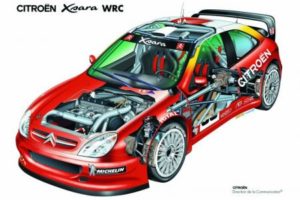Just when you knew what to expect from a 5 door hatchback – along comes the new Citroën Xsara
…was how the model was launched in November 1997.
The Xsara (available in X, LX, SX and Exclusive trim, as well as VTR and VTS coupes) was a direct replacement for the ground breaking, but by then ageing, ZX from which it used a modified floorpan. Whilst relatively plain looking, it was sold on four main virtues – Quality, Comfort, Safety and Driving pleasure.
It was a step forward from the ZX and embraced new technological items such as automatic windscreen wipers, lateral airbags, pollen air filtration and heat reflective glass fitted as standard on many models. In February 1998 the range was expanded to include 3 door Coupe models and in April Estates.
Citroën have always been at the cutting edge of Diesel Technology, and in 1999 the Xsara was one of the first models to be fitted with the latest HDi common rail Diesels which combined high efficiency with near petrol performance.
Probably the most important development was the introduction of the Xsara Picasso in July 2000, initially in LX and SX guises, with a choice of 2 petrol and 1 diesel engines. Like Citroëns of old many new features were introduced, such as multiplex technology minimising the electrical wiring necessary, ‘guide you home’ headlights, digital interactive dashboard, NCAP 4 star crash test safety and much more.
Whether it was due to Citroën keen pricing policy or just sheer value for money, the Picasso was a major marketing success.
 The Xsara provided Citroën with their return to motorsport, in the World Rally Championship. The first year (2003) brought considerable success with Citroen winning the Manufacturers Championship, along with its leading driver coming second in the Drivers Championship, thus proving the cars strength and pace. 2004 brought more successes – like any good wine the Xsara World Rally Car just kept getting better and better – to the extent that it was hard to believe that it was only Citroën’s second full year in WRC. Despite concerns that the car was becoming aged, the team continued to deliver incredible results. Over the next few years, Citroën became the team to beat in WRC.
The Xsara provided Citroën with their return to motorsport, in the World Rally Championship. The first year (2003) brought considerable success with Citroen winning the Manufacturers Championship, along with its leading driver coming second in the Drivers Championship, thus proving the cars strength and pace. 2004 brought more successes – like any good wine the Xsara World Rally Car just kept getting better and better – to the extent that it was hard to believe that it was only Citroën’s second full year in WRC. Despite concerns that the car was becoming aged, the team continued to deliver incredible results. Over the next few years, Citroën became the team to beat in WRC.
Although in production for virtually seven years, the Xsara still represented excellent value for money. All good things must come to an end, though, and all models bar the Picasso were replaced in late 2004 by the C4. The Picasso proved so popular it continued in the range for another six years, sitting as a ‘value’ alternative to the C4 Picasso until 2010.


